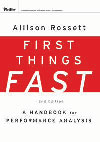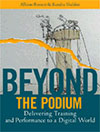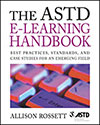A few years ago, Jim Marshall and I surveyed workplace learning professionals about elearning. Although we set out to learn about the contours of the elearning terrain, our project revealed much about instructional design practice today.
We pursued this question: when doing elearning, what are you doing? Were learning professionals relying on webinars, on podcasts, on mobile learning? What of scenario-based online programs, social networks and communities, discussion boards, or personalized programs?
We expected to find reliance on podcasts and scenarios, with healthy use of online communities and discussion boards. But when given the opportunity to rate twenty-six approaches from typical of practice to rare, respondents surprised us. Mostly, they used technology to enable those practices associated with good old fashioned instructional design.
The most frequently occurring use of technology reported by workplace professionals was for testing skills and knowledge. Interestingly, testing even surpassed classroom delivery via computers, though by a narrow margin. Tutorials, scenario-based learning, practice and feedback, and problem-solving strategies were identified as typical.
Practitioners inclined towards the familiar in mid 2009. Meat and potatoes ID dominated, with little reported of ID or technology that would be seen as new. We didn’t find much mobile or user generated content and scarcely any use of discussion boards either, except in higher education.
I harkened back to these findings after reading Xyleme CLO Jeffrey Katzman’s provocative blog posting about new instructional design. Katzman proclaims “a new world for the instructional designer,” with 3-ring binders kicked to the curb. He encourages instructional designers to relinquish control and cease reliance on “a process of extracting and interpreting information from the SME…. ” Katzman continues, “The expertise is out in the field …. In some cases the learner is the teacher, and teacher a learner.”
Appealing? Yes. Realistic? Not so much, not today. The 2009 study gives me pause. We are only now integrating good old fashioned ID.
What is this good old fashioned ID?
- Theory drives practice. There are reasons for the decisions that are made, and those decisions are based on the literature and best practices regarding learning, communications, technology and culture. Years back I did a project for a government agency. The director urged me to consider his behavioral roots, to make sure that participants received lots of opportunities to practice because that’s how people learn.
- Data direct decisions. Instructional designers make decisions based on data from many sources, including clients, job incumbents, the literature, work products, and error rates. Data focus the instructional designer’s attention, with output from one phase of the effort enlightening subsequent actions and decisions. When a client says, “Train them about performance appraisals,” instructional designers look to narrow the problem by turning to data, such as existing appraisals, help desk logs, and law suits. Where are the problems with the appraisals? Where are they not?
- Causes count. Once the mission is targeted, instructional designers want to know WHY. Why are appraisal forms flawed? Why is line 7 filled out inconsistently? Why are lines 2, 3, and 5 and 6 on point? Is it that they don’t know how or that they don’t think it’s worth doing or that doing it results in a hassle? Why does the group in Belgium do it, when the group in Boston doesn’t? Once causes are known, then a solution system can be tailored to the situation.
- Instruction is good, but not sufficient. Wise instructional designers ask questions about cause in order to use instructional resources where they can do the most good. Back to the appraisal challenge. Are the flaws in line 7 caused by not knowing how to write it up? Have they forgotten? Do supervisors doubt the value of line 7 or fear that honest and detailed entries could lead to unhappy employees or even lawsuits? If doubts and fears cause lame entries, training alone won’t improve performance. Instruction is only one thing we can do to develop and enhance performance.
- Outcomes rule. While there is disagreement from constructivists about how very royal outcomes are, most instructional designers subscribe to the importance of defining what participants will be able to do as a result of the learning experiences– and of guiding their experiences.
- Learning comes from action. The evidence is clear. Practice is critical to performance and even more of it leads to expertise.
- Teams deliver. Cross-disciplinary teams, with content experts, programmers, artists, and clients, join instructional designers to create the program in an orderly fashion. A recent project for a federal agency involved dozens of content experts, two senior instructional designers, a programmer, graphic artist, and two graduate student interns. They worked together, under the leadership of an instructional designer, in service to a client organization. Deliverables were established on the basis of analysis; outcomes articulated; and roles and approaches defined and honored.
Your mother’s ID proclaimed itself to be about outcomes, practice, data and authoritative sources. The Katzman blog posting, and influential voices like Jane Bozarth and Jay Cross, encourage us to consider a new ID that is characterized by informality, choice, learner centricity, and connections. While I don’t think this new ID is yet prevalent in the enterprise, in organizations like the military or financial services firms so dominated by compliance pressures, that doesn’t mean it shouldn’t be on the table. And there are glimmers. How would it work?
Benchmarks for the new ID
Is the ID that you and colleagues practice different today than it was a few years ago? If you and your unit were making strides towards the practice of this new instructional design, what would it look like to participants?
Here are some benchmarks:
- Participants enjoy MORE choices regarding WHAT they learn.
- Participants enjoy MORE choices about HOW they learn, including when and where.
- Participants have access to MORE sources of expertise, with appreciation for what they have to learn from each other.
- Participants enjoy MORE learning, collaboration, support and information IN THE WORKPLACE.
- Participants CONNECT MORE often, using technology for conversations with peers, experts, and supervisors.
- Participants MORE OFTEN REACH for learning, support and information in the workflow, leveraging MOBILE devices.
- Programs are MORE OFTEN selected and focused based on intelligence gathered from internal and external SOCIAL MEDIA.
Something old AND something new
If you ask 100 instructional designers for a definition of ID, you won’t get one. You’ll get many. That was true when I wrote it a decade ago. It is even more true today.
Walter Dick, long time Florida State professor, now retired, provided this definition: instructional design is applied educational psychology. For Dick, with Lou Carey, so very influential in the 70s and 80s, ID roots were in educational psychology. They still are, but we must also appreciate the gifts we are receiving from evidence about how organizations work, the brain, communities and of course, the omnipresence of information technology. All are goosing our conceptions of instructional design and opening the ID 2.0 door.
Because this emerging ID is less about authenticated deliverables and more about user choices and experience, it is both attractive and risky. Many call it informal. Does it make sense for your organization and people? Might some of it make sense? American Express’ Frank Nguyen and I built a free tool to guide consideration about risks and readiness to move towards these forms. Recently, when demonstrating the tool in an engineering organization, they remarked at how valuable it was going to be in their conversations with line leaders.
Must we pick good old ID or the newer ID? Is it dichotomous? Practice vs connections? Outcomes vs choice? Causes vs idiosyncrasy? I hope not. I think not. Why not a tailored concoction, recognizing context and strategy and mitigating risks. What do you think?






I find that I’m practicing ID with a healthy respect for the fact that the learners are making choices about how to use what I provide them. They pick and choose, click that pesky “next” button whenever they want to, and ignore huge chunks of content that I think is critical to understanding.
It’s part of my commitment to try to spend more time living in the real world, as I get older. I used to pretend that learners went through all my pretty content exactly as I wanted them to, and clicked through to all my links, and studied all my expensive graphs. Once I started spending more time actually WATCHING people use what I built (and sobbing, quietly, in the background) the truth was revealed.
Learners gonna do what learners gonna do.
Agreed, Allison. IMHO, instructional design can get myopically focused on the four walls of the classroom (physical or virtual) or the start and end of a web-based training course. This would be akin to an architect designing a room rather than a house. To your point about informal, mobile, social — we need to be broad in our thinking and design learning experiences rather than (or in addition to) learning events.
Allison, it’s not either/or. Focusing on choice and connections doesn’t deny the importance of outcomes, practice, data and authoritative sources.
Informal Learning is not the solution to everything any more than ID is the only way to solve performance problems.
I currently work in a continuing ed unit in a large university. In some cases, a program director plays a decisive role on the content of a program. Upfront market research dictates the modality. It’s usually f2f or online. I work with Sme-instructors to develop each (online) course or program. It’s a collaborative process. It’s a project-based learning experience for the instructor too.
The ID I do consists of developing and executing a performance support infrastructure for him/her. It includes consulting, developing job aids, providing one-on-one guidance/training, organizing training workshops, coordinating learning communities.
It also consists of tedious configurations (aka course design) of Blackboard, if one could call that ID. I don’t. Sigh.
I have other types of projects too. I say though that the bulk of my work involves supporting the ID-like performances of instructors using technology for teaching and learning. I’m putting a paper together on it.
Allison,
Even though I am Instructional Design guy, as a learner I have to confess I have very little patience for sitting through a full e-learning course. There are times when I just want to go as far as needed to get the answer I am looking for. In those cases, I recognize that a simple job aid or access to an expert for a quick answer would have been just fine. We really need both elements to cover needs and preferences.
What stands out to me in this article is the term “learner centricity” and the emphasis on learners wanting more choices. It’s increasingly clear to me that the new generation of learners, armed with mobile devices and ever-shrinking attention spans, need to be entertained. A colleague of mine recently stated matter of factly that whether learners “like” something is becoming more and more important. If you can’t grab the audience’s attention you can’t get them at all. More than ever, the learner is really driving the direction of the training.
No doubt, access to technology changes the dynamic. Learners, participants, employees, whatever you want to call them, get to exert more choices. Will they? Will they look it up? Will they comment? Will they read? Will they reflect and apply?
John Seely Brown emphasizes the power of PULL. When will they pull? They will pull when they themselves see the value in it, when it relates to their goals, when the experience is pleasurable, when the effort yields a worthy result.
PULL is splendid, but probably not sufficient. Think about taste testing. PUSH isn’t crazy, within a work context, in order provide exposure to resources, communities and ideas. Will they PULL if they don’t know what’s out there and how and why it might be helpful?
In my blog post that you reference, I was deliberately being provocative to shake up the conversation and point out that perhaps the ID methodology is lagging behind cultural norms. The study referenced was from 2009 when the iPad didn’t even exist. Is it really a surprise that IDs don’t like change and would opt for the familiar rather than something different. I don’t contend that the using a disciplined approach isn’t valid for some types of learning. However, some types of learning are happening already with or without instructional designers. Look at YouTube. All I’m suggesting is that rather than bristle at it, ID’s might get a better outcome if they harness it.
In my work for the past 18 years doing ID for various clients and industries, I feel ID has not changed much, even across different modalities.
Most workplaces seem to be familiar and use the ADDIE model to document internal ID practices, resembling the Dick & Carey ID systems approach, although with some liberties depending on the project, client, SMEs, resources and modalities.
In my work for higher education clients, focus was on the students activities, tutor support and feedback systems.
In my work for corporate clients, it varied by the industry (a huge difference from financial organization to software companies, where there was more room for fun and creativity in the latter), size of organization, content areas within the industry, and how quickly it needed to be done, not to mention client receptivity and previous experience with ID and L&D.
Interactivity and learner centered approaches were hot topics a few years back.
I would say my ID focus has shifted now to improve on the on the job application of learning, many clients seem familiar and quote now the 70/20/10. Most recently, I am using team-based learning activities to accelerate development and boost learning application on the job, with interest in e.learning for large audiences and limited content. Still more strategic programs are developed with a large classroom-based components along with e.learning activities for pre and post work.
We are looking to use more social media to ensure that learning does not stop with the course completion, and avail access to SMEs and peer help when needed by the learners.
Knowledge management also became a part of the new vocabulary in the recent ID work I did the last few years.
Informal learning has been quite a big part of my work in the last year or so, clients were very interested in learning about it, how to measure it and how to integrate it in the work practices so to reduce formal training opportunities (as if it was the answer to our economic crisis to decrease training costs) although not sure if the term informal is quite descriptive to what I do, it involves design, development, organization, scheduling, observation and feedback, and evaluation, so not that ad hoc, and not so informal/organic really.
All in all, I rarely get to apply the full ADDIE in my projects, the A and E are a nice to have for the most part in my dept overall, although in my own projects, I insist to have at least both done, even though not to the extent thatI would ideally like.
Looking back at my answer, before posting it, I see perhaps in my instance, that indeed my ID work has changed, but not sure if it is because of technologies or learners demands, but may be more my own experience and maturity as an ID.
Thanks for the great post! I believe the steps necessary to succeed with ID is to first ask the “client” what they envision to be a successful outcome, then ask – how will we measure it. Once these variables are determined, the ID can determine and apply the strategies, theories, techniques, and tools, that will enable that success! Blended ID.
I also believe the 70-20-10 structure has many IDs insecure about their relevance, but as it was stated above, it is happening and we need to ensure that our learners have environments that provide them with effective, and efficient learning experiences whether they are push, or pull!
We are transferring skills and knowledge to people to enable them to operate heavy equipment and machinery. While a lot of this knowledge transfer occurs on the job by way of informal learning, we have to be careful that what is being passed on is the right information. Too often, we find that the learners pick up bad habits just as quickly, if not more quickly, than the good habits. Similar to the strange phenomenon of how a child in new country always picks up the cuss words first. Pulling learning is a great way of giving people control of managing their own development but we have to be careful that they have the right stuff to pull.
Thank you, Allison, for a thoughtful about ISD theory. I agree that over-reliance and focus on specific ISD theory doesn’t necessarily bring about better results, and can take precious time away from understanding what our customers want and how best to design their solution. However, mindfulness about ISD theory and foundations is important, when that’s coupled with the other components you mention.